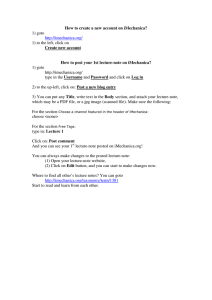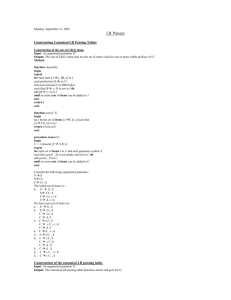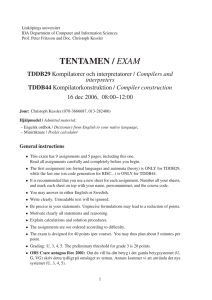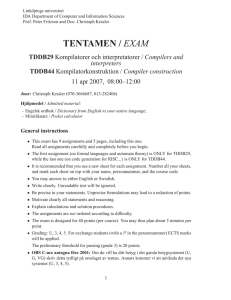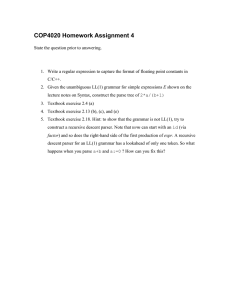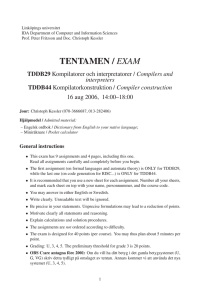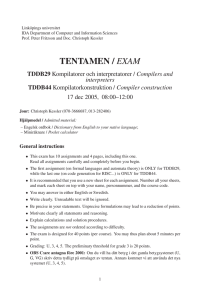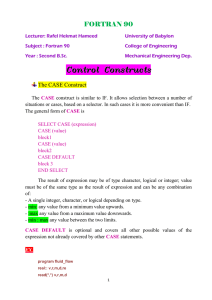MIT 6 035 MIT 6.035 Parse Table Construction Martin Rinard
advertisement
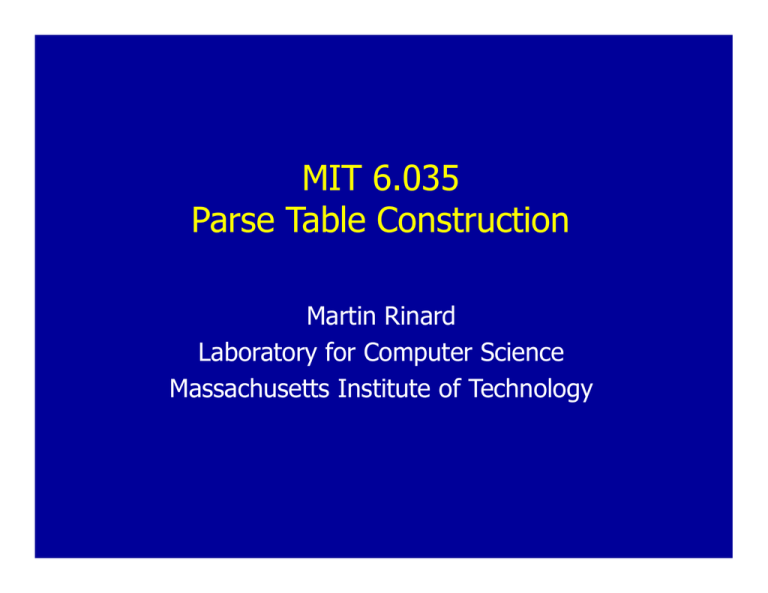
MIT 6.035
6 035
Parse Table Construction
Martin Rinard
Laboratory for Computer Science
Massachusetts Institute of Technology
Parse Tables (Review)
State
s0
s1
s2
s3
3
s4
s5
(
shift to s2
error
shift to s2
error
reduce (2)
reduce (3)
ACTION
)
error
error
shift to s5
shift
hift tto s4
4
reduce (2)
reduce (3)
Goto
$
error
accept
error
error
reduce (2)
reduce (3)
X
goto s1
goto s3
• Implements finite state control
• At each step, look up
T bl [
k] [ input
i
b l]
• Table[top
off state stack]
symbol]
• Then carry out the action
Parse Tables (Review)
State
s0
s1
s2
s3
3
s4
s5
(
shift to s2
error
shift to s2
error
reduce (2)
reduce (3)
ACTION
)
error
error
shift to s5
shift
hift tto s4
4
reduce (2)
reduce (3)
Goto
$
error
accept
error
error
reduce (2)
reduce (3)
X
goto s1
goto s3
• Shift to sn
• Push input token into the symbol stack
• Push sn into state stack
• Advance to next input symbol
Parse Tables (Review)
State
s0
s1
s2
s3
3
s4
s5
(
shift to s2
error
shift to s2
error
reduce (2)
reduce (3)
ACTION
)
error
error
shift to s5
shift
hift tto s4
4
reduce (2)
reduce (3)
Goto
$
error
accept
error
error
reduce (2)
reduce (3)
X
goto s1
goto s3
• Reduce (n)
• Pop both stacks as many times as the number
off symbols
b l on the
th RHS off rule
l n
• Push LHS of rule n into symbol stack
Parser Generators and Parse Tables
• Parser generator (YACC, CUP)
• Given a grammar
• Produces a (shift-reduce) parser for that grammar
• Process grammar to synthesize a DFA
• Contains states that the parser can be in
• State transitions for terminals and non-terminals
• Use DFA to create an parse table
• Use parse table to generate code for parser
Example
p
• The grammar
S → X $
X → (X )
X→ ( )
(1)
( )
(2)
(3)
DFA States Based on Items
• We need to capture how much of a given
production we have scanned so far
X
→ (
X
)
Are we here? Or here? Or here? Or here?
Items
• We need to capture how much of a given
production we have scanned so far
X
→ (
X
• Production Generates 4 items
•
•
•
•
X →
X→
X→
X→
• (X )
( •X)
(X • )
(X ) •
)
Example
p of Items
• The grammar
S →X $
X → (X )
X→ ( )
• Items
S → •X$
S→X• $
X → • (X )
X→(•X)
X → (X • )
X → (X ) •
X→ • ( )
X→( • )
X→(
) •
Notation
• If write production as A → α c β
• α is sequence of grammar symbols, can be
terminals and nonterminals in sequence
• c is terminal
• β is sequence of grammar symbols, can be
terminals and nonterminals in sequence
• If write production as A→ α • B β
• α, β as above
• B is a single grammar symbol, either terminal or
nonterminal
Key idea behind items
• States correspond to sets of items
• If the state contains the item A → α • c β
• Parser
Parser is expecting to eve
eventually
ntually rreduce
educe u
using
sing the
production A → α c β
• Parser has alreadyy p
parsed an α
• It expects the input may contain c, then β
• If the state contains the item A → α •
• Parser has already parsed an α
• Will reduce using A → α
• If th
the state
t t contains
t i th
the it
item S → α • $
and the input buffer is empty
Parser accepts input
– Parser
Correlating Items and Actions
• If the current state contains the item A → α • c β
and the current symbol in the input buffer is c
• Parser shifts c onto stack
• Next state will contain A → α c • β
• If the current state contains the item A → α •
• Parser reduces using A → α
• If the current state contains the item S → α • $
p buffer is empty
py
and the input
• Parser accepts input
Closure() of a set of items
• Closure finds all the items in the same “state”
• Fixed
Fi d Point
P i t Algorithm
Al ith for
f Closure(I)
Cl
(I)
• Every item in I is also an item in Closure(I)
• If A
A→
→ α • B β is in Closure(I) and B→
B→ • γ is
an item, then add B→ • γ to Closure(I)
• Repeat until no more new items can be added
to Closure(I)
Example
p of Closure
• Closure({X→ ( • X )})
X→
( •X)
X → • (X )
X→ • ( )
• Items
S → •X$
S→X• $
X → • (X )
X→(•X)
X → (X • )
X → (X ) •
X→ • ( )
X→(• )
X→(
) •
Another Example
p
• closure({S → • X $})
S→
•X$
X → • (X )
X→ • ( )
• Items
S → •X$
S→X• $
X → • (X )
X→(•X)
X → (X • )
X → (X ) •
X→ • ( )
X→(• )
X→(
) •
Goto() of a set of items
• Goto finds the new state after consuming a
grammar symbol while at the current state
Goto(I, X)
• Algorithm for Goto(I
where I is a set of items
and X is a grammar symbol
Goto(I, X) = Closure( { A→ α X • β | A→ α • X β in I })
• goto is the new set obtained by “moving
the dot”
dot over X
Example
p of Goto
• Goto ({X → ( • X )}, X )
X → (X • )
• Items
S → •X$
S→X• $
X → • (X )
X→(•X)
X → (X • )
X → (X ) •
X→ • ( )
X→(• )
X→(
) •
Another Example
p of Goto
• Goto ({X → •(X )}, ()
X→
( •X)
X → • (X )
X→ • ( )
• Items
S → •X$
S→X• $
X → • (X )
X→(•X)
X → (X • )
X → (X ) •
X→ • ( )
X→(• )
X→(
) •
Building the DFA states
• Start with the item S → • β $
• Create the first state to be Closure({ S → • β $})
• Pick a state I
• for each item A→ α • X β in I
• find Goto(I, X)
• if Goto(I, X) is not already a state, make one
• Add an edge X from state I to Goto(I, X) state
• Repeat until no more additions possible
DFA Example
s1
X
S→X•$
s0
S→•X$
X → • (X )
X→•()
S →X $
X → (X )
X→ ( )
s2
(
X→(•X)
X→ (•)
X → • (X )
X →•()
(
s3
X → (X • )
X
s5
5
X→()•
)
s4
4
X → (X ) •
)
Constructing A Parse Engine
• Build a DFA - DONE
• Construct a parse table using the DFA
Creating the parse tables
• For each state
• Transition to another state using a terminal symbol is a
shift to that state (shift to sn)
• Transition
T
iti to
t another
th state
t t using
i a non-terminal
t
i l is
i a goto
t
to that state (goto sn)
• If there is an item A → α • in the state
do a reduction with that production for all terminals
(reduce k)
Building Parse Table Example
State
s0
s1
s2
s3
s4
4
s5
(
shift to s2
error
shift to s2
error
reduce
(2)
d
reduce (3)
$
X
goto s1
error
accept
error
error
reduce
(2)
d
reduce (3)
goto s3
S→X•$
s0
S →X $
X → (X )
X→ ( )
Goto
s1
X
S→•X$
X → • (X)
X→•()
ACTION
)
error
error
shift to s5
shift to s4
reduce
(2)
d
reduce (3)
s2
(
X→(•X)
X→ (•)
X → • (X )
X →•()
(
s3
X → (X • )
X
s5
X→()•
)
s4
X → (X ) •
)
Potential Problem
• No lookahead
• Vulnerable to unnecessary conflicts
• Shift/Reduce Conflicts (may reduce too soon in
some cases)
• Reduce/Reduce Conflicts
• Solution: Lookahead
• Only for reductions - reduce only when next
symbol can occur after nonterminal from
production
• Systematic
S t
ti llookahead,
k h d split
lit states
t t based
b d on nextt
symbol, action is always a function of next symbol
• Can generalize to look ahead multiple symbols
Reduction-Only Lookahead Parsing
• If a state contains A→ β •
• Reduce
Red e b
by A→ β only
onl if next
ne t input
inp t symbol
mbol can
n
follow A in some derivation
• Example Grammar
S → X$
X →a
X →ab
Parser Without Lookahead
State
s0
s1
s2
s3
a
shift to s1
reduce(2)
reduce(3)
error
ACTION
b
error
S/R Conflict
reduce(3)
error
Goto
$
X
goto s3
error
reduce(2)
reduce(3)
accept
s3
s0
X
S→ •X$
X →•a
X →•ab
S→ X•$
s2
X →ab•
s1
a
X →a•
X →a•b
b
S → X$
X →a
X →ab
Creating parse tables with reductiononly lookahead
• For each state
• Transition to another state using a terminal symbol is a
shift to that state (shift to sn) (same as before)
• Transition to another state using a non
non-terminal
terminal is a goto
that state (goto sn) (same as before)
• If there is an item X → α • in the state
d a reduction
do
d i with
i h that
h production
d i whenever
h
the
h current
input symbol T may follow X in some derivation (more
precise than before)
• Eliminates useless reduce actions
New Parse Table
State
s0
s1
s2
s3
a
shift to s1
reduce(2)
reduce(3)
error
b never follows X in any derivation
resolve shift/reduce
/
conflict to shift
ACTION
b
error
shift to s2
reduce(3)
error
Goto
X
goto s3
$
error
reduce(2)
reduce(3)
accept
s3
s0
X
S→ •X$
X →•a
X →•ab
S→ X•$
s2
X →ab•
s1
a
X →a•
X →a•b
b
S → X$
X →a
X →ab
More General Lookahead
• Items contain potential lookahead information,
resulting in more states in finite state control
• Item of the form [A → α • β T] says
• The parser has parsed an α
• If it parses a β and the next symbol is T
• Then parser should reduce by A → α β
• In addition to current parser state, all parser
actions are function of lookahead symbols
Terminology
• Many different parsing techniques
• Each can handle some set of CFGs
• Categorization of techniques
Terminology
• Many different parsing techniques
• Each can handle some set of CFGs
• Categorization of techniques
(
)
Terminology
• Many different parsing techniques
• Each can handle some set of CFGs
• Categorization of techniques
• L - parse from left to right
• R - parse from right to left
(
)
Terminology
• Many different parsing techniques
• Each can handle some set of CFGs
• Categorization of techniques
• L - leftmost derivation
• R - rightmost derivation
(
)
Terminology
• Many different parsing techniques
• Each can handle some set of CFGs
• Categorization of techniques
• Number of lookahead characters
(
)
Terminology
• Many different parsing techniques
• Each can handle some set of CFGs
• Categorization of techniques
• Examples: LL(0), LR(1)
• This lecture
L R
k
• LR(0) parser
• SLR parser – LR(0) parser augmented with
follow information
(
)
Summary
• Parser generators – given a grammar, produce a parser
• Standard technique
• Automatically build a pushdown automaton
• Obtain a shift-reduce parser
• Finite state control plus push down stack
• Table driven implementation
• Conflicts: Shift/Reduce,
Shift/Reduce Reduce/Reduce
• Use of lookahead to eliminate conflicts
• SLR parsing (eliminates useless reduce actions)
• LR(k) parsing (lookahead throughout parser)
Follow() sets in SLR Parsing
For each non-terminal
non-terminal A, Follow(A) is the set of
terminals that can come after A in some derivation
Constraints for Follow()
•
•
•
•
$ ∈ Follow(S ), where S is the start symbol
If A → αB β is a production then First(β) ⊆ Follow(B )
If A → αB is a production then Follow(A) ⊆ Follow(B )
If A → αB β is
i a production
d ti
and
d β derives
d i
ε
then Follow(A) ⊆ Follow(B )
Algorithm
g
for Follow
for all nonterminals NT
Follow(NT) = {}
Follow(S ) = { $ }
while
hil Follow
F ll
sets
t keep
k
changing
h
i
for all productions A → αB β
Follow(B ) = Follow(B ) ∪ First(β)
if (β derives ε) Follow(B ) = Follow(B )∪Follow(A )
for all productions
p
A → αB
Follow(B ) = Follow(B )∪Follow(A )
Augmenting Example with Follow
• Example Grammar for Follow
S → X$
X →a
X →ab
Follow((S ) = { $ }
Follow(X ) = { $ }
SLR Eliminates Shift/Reduce Conflict
State
s0
s1
s2
s3
a
shift to s1
reduce(2)
( )
reduce(3)
error
ACTION
b
error
shift to s2
reduce(3)
error
Goto
$
error
( )
reduce(2)
reduce(3)
accept
s3
s0
X
S→ •X$
X →•a
X →•ab
S→ X•$
s2
a
b∉Follow(X)
X →ab•
s1
X →a•
X →a•b
X
goto s3
b
Basic Idea Behind LR(1)
• Split states in LR(0) DFA based on lookahead
• Reduce
R d
b
based
d on item
it
and
d lookahead
l k h d
LR(1)
( ) Items
• Items will keep info on
• production
• right-hand-side position (the dot)
• look ahead symbol
•• LR(1) item is of the form [A → α • β
T]
• A → α β is a production
• The dot in A → α • β denotes the position
• T is a terminal or the end marker ($)
Meaning
g of LR(1)
( ) Items
• Item [A → α • β
T] means
• The parser has parsed an α
• If it parses a β and the next symbol is T
• Then parser should reduce by A → α β
• The grammar
S → X$
X → (X)
X→ ε
• Terminal symbols
• ‘(‘
( ‘)’
)
• End of input symbol
• ‘$’
LR(1)
( ) Items
[S → • X $
[S → • X $
[S → • X $
[S → X • $
[S → X • $
[S → X • $
[X → • (X)
[X → • (X)
[X → • (X)
[X →
( • X)
[X →
( • X)
[X →
( • X)
)]
(]
$]
)]
(]
$]
)]
(]
$]
)]
(]
$]
[X
[X
[X
[X
[X
[X
[X
[X
[X
→
→
→
→
→
→
→
→
→
(X •
)]
(X • )
(]
(X • )
$]
(X) • ) ]
(X) • ( ]
(X) • $ ]
• )]
• (]
• $]
Creating
g a LR(1)
( ) Parser Engine
g
• Need to define Closure() and Goto() functions for
LR(1) items
• Need
N d tto provide
id an algorithm
l ith to
t create
t tthe
h DFA
• N
Need
d tto provide
id an algorithm
l ith to
t create
t th
the parse
table
Closure algorithm
g
Closure(I)
repeat
for all items [A → α • X β c] in I
for any production X → γ
for any d ∈ First(βc)
I = I ∪ { [X → • γ d] }
until I does not change
Goto algorithm
g
Goto(I, X)
J={}
for any item [A → α • X β c] in I
J = J ∪ {[A → α X • β c]}
return Closure(J)
( )
Building
g the LR(1)
( ) DFA
• Start with the item [<S’> → • <S> $ I]
• I irrelevant because we will never shift $
• Find the closure of the item and make an state
• Pick a state I
• for each item [A→ α • X β c] in I
• find Goto(I, X)
• if Goto(I, X) is not already a state, make one
• Add an edge X from state I to Goto(I, X) state
• Repeat until no more additions possible
Creating
g the parse
p
tables
• For each LR(1) DFA state
• Transition to another state using a terminal
symbol is a shift to that state (shift to sn)
• Transition to another state using a non-terminal
symbol is a goto that state (goto sn)
• If there is an item [A → α • a] in the state,
action for input symbol a is a reduction via the
production A → α (reduce k)
LALR(1)
( ) Parser
• Motivation
• LR(1) parse engine has a large number of states
• Simple method to eliminate states
• If two LR(1) states are identical except for the look
ahead symbol of the items
Then Merge the states
• Result is LALR(1) DFA
• Typically has many fewer states than LR(1)
• May also have more reduce/reduce conflicts
MIT OpenCourseWare
http://ocw.mit.edu
6.035 Computer Language Engineering
Spring 2010
For information about citing these materials or our Terms of Use, visit: http://ocw.mit.edu/terms.
